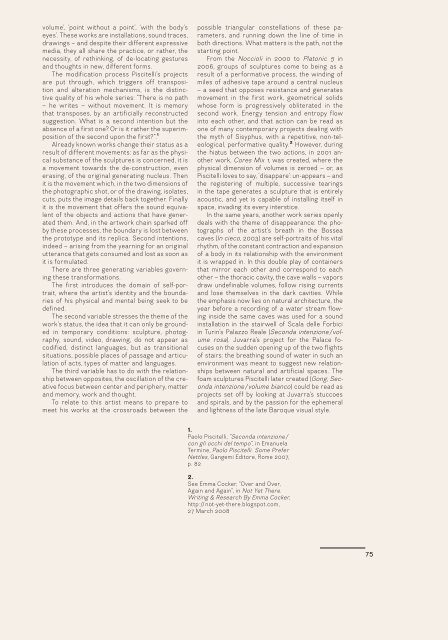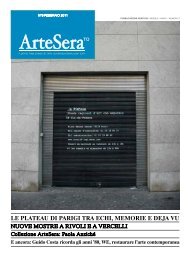Download Catalogue - Paola Anziché
Download Catalogue - Paola Anziché
Download Catalogue - Paola Anziché
You also want an ePaper? Increase the reach of your titles
YUMPU automatically turns print PDFs into web optimized ePapers that Google loves.
volume’, ‘point without a point’, ‘with the body’s<br />
eyes’. These works are installations, sound traces,<br />
drawings – and despite their different expressive<br />
media, they all share the practice, or rather, the<br />
necessity, of rethinking, of de-locating gestures<br />
and thoughts in new, different forms.<br />
The modification process Piscitelli’s projects<br />
are put through, which triggers off transposition<br />
and alteration mechanisms, is the distinctive<br />
quality of his whole series: “There is no path<br />
– he writes – without movement. It is memory<br />
that transposes, by an artificially reconstructed<br />
suggestion. What is a second intention but the<br />
absence of a first one? Or is it rather the superimposition<br />
of the second upon the first?”. 1<br />
Already known works change their status as a<br />
result of different movements: as far as the physical<br />
substance of the sculptures is concerned, it is<br />
a movement towards the de-construction, even<br />
erasing, of the original generating nucleus. Then<br />
it is the movement which, in the two dimensions of<br />
the photographic shot, or of the drawing, isolates,<br />
cuts, puts the image details back together. Finally<br />
it is the movement that offers the sound equivalent<br />
of the objects and actions that have generated<br />
them. And, in the artwork chain sparked off<br />
by these processes, the boundary is lost between<br />
the prototype and its replica. Second intentions,<br />
indeed – arising from the yearning for an original<br />
utterance that gets consumed and lost as soon as<br />
it is formulated.<br />
There are three generating variables governing<br />
these transformations.<br />
The first introduces the domain of self-portrait,<br />
where the artist’s identity and the boundaries<br />
of his physical and mental being seek to be<br />
defined.<br />
The second variable stresses the theme of the<br />
work’s status, the idea that it can only be grounded<br />
in temporary conditions: sculpture, photography,<br />
sound, video, drawing, do not appear as<br />
codified, distinct languages, but as transitional<br />
situations, possible places of passage and articulation<br />
of acts, types of matter and languages.<br />
The third variable has to do with the relationship<br />
between opposites, the oscillation of the creative<br />
focus between center and periphery, matter<br />
and memory, work and thought.<br />
To relate to this artist means to prepare to<br />
meet his works at the crossroads between the<br />
possible triangular constellations of these parameters,<br />
and running down the line of time in<br />
both directions. What matters is the path, not the<br />
starting point.<br />
From the Noccioli in 2000 to Platonic 5 in<br />
2006, groups of sculptures come to being as a<br />
result of a performative process, the winding of<br />
miles of adhesive tape around a central nucleus<br />
– a seed that opposes resistance and generates<br />
movement in the first work, geometrical solids<br />
whose form is progressively obliterated in the<br />
second work. Energy tension and entropy flow<br />
into each other, and that action can be read as<br />
one of many contemporary projects dealing with<br />
the myth of Sisyphus, with a repetitive, non-teleological,<br />
performative quality. 2 However, during<br />
the hiatus between the two actions, in 2001 another<br />
work, Cores Mix 1, was created, where the<br />
physical dimension of volumes is zeroed – or, as<br />
Piscitelli loves to say, ‘disappare’: un-appears – and<br />
the registering of multiple, successive tearings<br />
in the tape generates a sculpture that is entirely<br />
acoustic, and yet is capable of installing itself in<br />
space, invading its every interstice.<br />
In the same years, another work series openly<br />
deals with the theme of disappearance: the photographs<br />
of the artist’s breath in the Bossea<br />
caves (In cieco, 2003) are self-portraits of his vital<br />
rhythm, of the constant contraction and expansion<br />
of a body in its relationship with the environment<br />
it is wrapped in. In this double play of containers<br />
that mirror each other and correspond to each<br />
other – the thoracic cavity, the cave walls – vapors<br />
draw undefinable volumes, follow rising currents<br />
and lose themselves in the dark cavities. While<br />
the emphasis now lies on natural architecture, the<br />
year before a recording of a water stream flowing<br />
inside the same caves was used for a sound<br />
installation in the stairwell of Scala delle Forbici<br />
in Turin’s Palazzo Reale (Seconda intenzione / volume<br />
rosa). Juvarra’s project for the Palace focuses<br />
on the sudden opening up of the two flights<br />
of stairs: the breathing sound of water in such an<br />
environment was meant to suggest new relationships<br />
between natural and artificial spaces. The<br />
foam sculptures Piscitelli later created (Gong, Seconda<br />
intenzione / volume bianco) could be read as<br />
projects set off by looking at Juvarra’s stuccoes<br />
and spirals, and by the passion for the ephemeral<br />
and lightness of the late Baroque visual style.<br />
1.<br />
Paolo Piscitelli, “Seconda intenzione /<br />
con gli occhi del tempo”, in Emanuela<br />
Termine, Paolo Piscitelli. Some Prefer<br />
Nettles, Gangemi Editore, Rome 2007,<br />
p. 82<br />
2.<br />
See Emma Cocker, “Over and Over,<br />
Again and Again”, in Not Yet There.<br />
Writing & Research By Emma Cocker,<br />
http: // not-yet-there.blogspot.com,<br />
27 March 2008<br />
75



